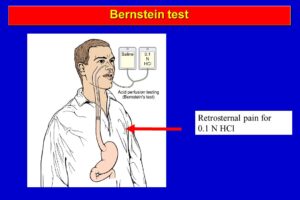The Bernstein test is a diagnostic procedure that simulates the symptoms of gastroesophageal reflux disease (GERD) by dripping a mild acid solution into the lower esophagus. It is used to confirm or rule out GERD as the cause of chest pain, heartburn, or other discomforts. The test is also known as the acid perfusion test or the intraesophageal acid perfusion test.
To find treatment options for Acid reflux using medical devices, Click here to select the most suitable device for your condition.
Purpose of the Bernstein Test
The test aims to reproduce symptoms of gastroesophageal reflux disease (GERD) by introducing an acid solution directly into the esophagus. If the patient experiences the same symptoms during the test as they normally do, GERD is likely the cause. If the symptoms do not occur, the discomfort might be caused by another condition.
Procedure
During the Bernstein test, a thin tube is inserted through the nose and guided into the esophagus. First, a saline solution is instilled into the esophagus, followed by a mild acid solution that mimics stomach acid. The patient is asked to report any symptoms they experience, particularly chest pain or discomfort. The process is done in alternating intervals between saline and acid to compare responses and assess acid sensitivity in the esophagus.
Interpretation of Results
- Positive Bernstein Test: If the acid solution causes symptoms like heartburn or chest pain that match the patient’s usual experience, it suggests that the esophagus is sensitive to acid and GERD may be the diagnosis.
- Negative Bernstein Test: If the acid solution does not trigger symptoms, it implies that acid reflux might not be the source of the discomfort, leading the physician to explore other causes.
What are the risks?
Esophageal pH testing is a safe procedure. However, you may experience some complications. These include:
- A sore throat
- Nausea
- Vomiting
- Discomfort when swallowing
Significance and Limitations
The Bernstein test is useful for confirming acid reflux as the cause of symptoms in patients who may not have obvious signs of GERD. However, it is not commonly used today because other diagnostic tests like 24-hour pH monitoring and endoscopy are more precise and less invasive. Nonetheless, it remains an important historical tool in the assessment of acid-related esophageal conditions.


